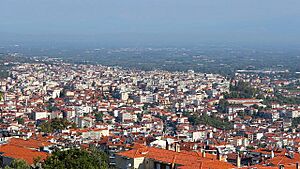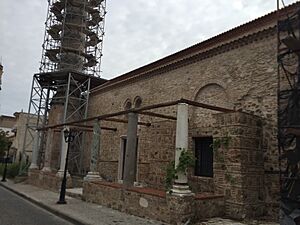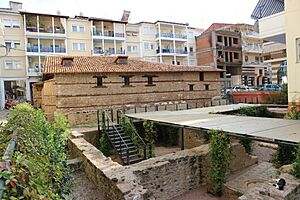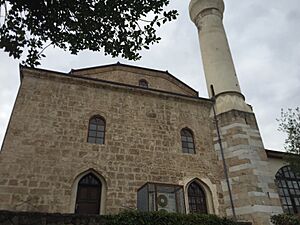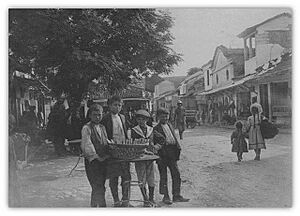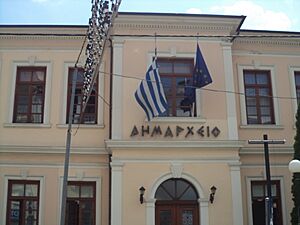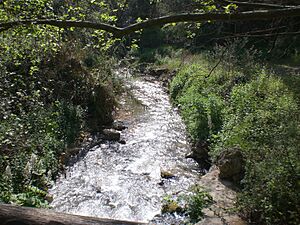Veria facts for kids
Quick facts for kids
Veria
Βέροια
|
||
|---|---|---|
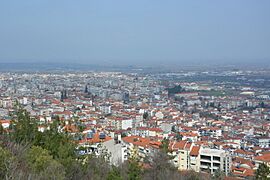
Panoramic view
|
||
|
||
| Country | Greece | |
| Administrative region | Central Macedonia | |
| Regional unit | Imathia | |
| Area | ||
| • Municipality | 796.5 km2 (307.5 sq mi) | |
| • Municipal unit | 359.1 km2 (138.6 sq mi) | |
| Elevation | 128 m (420 ft) | |
| Population
(2021)
|
||
| • Municipality | 62,655 | |
| • Municipality density | 78.663/km2 (203.736/sq mi) | |
| • Municipal unit | 46,976 | |
| • Municipal unit density | 130.816/km2 (338.81/sq mi) | |
| Time zone | UTC+2 (EET) | |
| • Summer (DST) | UTC+3 (EEST) | |
| Postal code |
591 31, 591 32
|
|
| Area code(s) | 2331 | |
| Vehicle registration | ΗΜ | |
| Website | www.veria.gr | |
| UNESCO World Heritage Site | ||
| Official name | Archaeological Site of Aigai (modern name Vergina) | |
| Includes |
|
|
| Criteria | Cultural: (i)(iii) | |
| Inscription | 1996 (20th Session) | |
| Area | 1,420.81 ha (3,510.9 acres) | |
| Buffer zone | 4,811.73 ha (11,890.0 acres) | |
Veria (Greek: Βέροια or Βέρροια, romanized: Véroia or Vérroia) is an old and important city in northern Greece. It is the capital of the Imathia region in Central Macedonia. Veria is about 511 kilometers (317 miles) northwest of Athens, the capital of Greece. It is also 73 kilometers (45 miles) southwest of Thessaloniki, a major Greek city.
Veria has a very long history, dating back to at least 1000 BC. It was first mentioned in writings around 432 BC. The city was important to Philip II of Macedon, who was the father of Alexander the Great. Later, it became a key city for the Roman Empire. The Apostle Paul visited Veria and preached there, making its people some of the first Christians in the Roman Empire.
Over time, under the Byzantine Empire and the Ottoman Empire, Veria became a center for Greek culture and learning. Today, it is a busy commercial hub in Central Macedonia. It is also the home of a Christian bishop.
Just 12 kilometers (7 miles) southeast of Veria is the amazing archaeological site of Vergina. This site, also known as ancient Aigai, was the first capital of Macedon. It is a UNESCO World Heritage Site and contains the tomb of Philip II of Macedon.
Contents
Veria's Long History
Ancient Times: Classical and Roman Veria
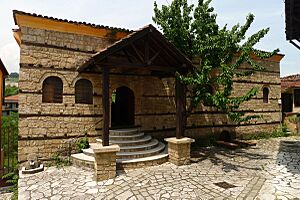
People believe Veria was named after its mythical founder, Beres, or after the daughter of a king named Berroia. The city became very rich and powerful under the kings of the Argead Dynasty, which included Alexander the Great. It was their second most important city after Pella.
Veria was at its peak during the Hellenistic period, under the Antigonid Dynasty. During this time, it became the center of the Koinon of Macedonians, a group of Macedonian cities. Veria even made its own coins and held sports games called Alexandreia. Athletes from all over Greece came to compete in honor of Alexander the Great.
Veria surrendered to Rome in 168 BC. During the Roman empire, Veria became a place where Romans worshipped. The Roman emperor Diocletian made this large city one of the two capitals of the Roman province of Macedonia.
Apostle Paul's Visit to Veria
Veria had a Jewish community. The Apostle Paul and his friend Silas visited Veria around AD 50 or 54. They preached to both Jewish and Greek people in the city. The Bible says that the people of Veria were very open-minded. They eagerly listened to Paul's message and checked the Scriptures every day to see if what he said was true. Many people believed him.
However, some people from Thessalonica, where Paul had preached before, came to Veria and caused trouble. So, Paul was sent to Athens, while Silas and Timothy stayed in Veria for a while.
Recent Discoveries in Veria
In December 2021, archaeologists found an unfinished Roman-era statue of a young athletic man in Veria. This headless marble statue is about three feet tall. Experts from Greece's Culture Ministry say it looks similar to statues of the Greek gods Apollo and Hermes.
Byzantine Veria: A Center of Learning
Under the Byzantine Empire, Veria continued to grow and do well. It had many educated merchants, both Greek and Jewish. The city became an important center for Greek learning in the Middle Ages. You can still see signs of this wealth in the many Byzantine churches built during this time.
In the 7th century, a Slavic tribe called the Drougoubitai raided the areas near the city. Later, in the late 8th century, Empress Irene of Athens is said to have rebuilt and expanded Veria. She may have even named it Irenopolis after herself.
Veria was briefly controlled by the First Bulgarian Empire in the late 9th century. An 11th-century Greek bishop wrote that the Bulgarian Tsar Boris I built one of his seven important churches there. The city changed hands several times over the centuries, being taken by Bulgarians, Normans, and rulers from Epirus and Nicaea. It became part of the restored Byzantine Empire after 1261.
The 14th century was a difficult time for Veria. The area was attacked by Turks in 1331. Then, the Serbian ruler Stephen Dushan captured it in 1343/4, making it part of his Serbian Empire. Veria returned to Byzantine control for a short time but was always threatened by the rising Ottoman Turks. The Ottomans finally conquered Veria around 1430.
Ottoman Veria: Karaferye
The Ottomans called Veria Karaferye, which means "black Veria." This was because of the morning mist that often covered the city during the humid winter. In 1519, Veria had more Christian households than Muslim ones.
Under Ottoman rule, Veria was a local administrative center. By 1885, the area around Veria included 46 villages. A traveler in the 17th century noted that the city was peaceful and had no walls or soldiers. It had 4,000 houses and many Muslim, Christian, and Jewish neighborhoods. Veria was a successful center for growing rice.
Veria was an important regional center for Greek trade and education. Many famous Greek scholars came from Veria.
Modern Veria: Joining Greece
Veria had many wealthy and educated citizens, which made it a center for Greek nationalism in Macedonia. The people of Veria played an active role in the Greek War of Independence. However, the uprising in northern Greece was eventually defeated.
Veria finally became part of modern Greece in 1912 during the Balkan Wars. The Greek Army took the city on October 16, 1912. This date is now an official holiday in Veria, celebrating the city joining Greece. It was officially added to Greece after the Treaty of Athens was signed in November 1913.
World War II and After
During World War II, Veria was occupied by the Nazis from 1941 to 1944. A strong resistance movement grew in the city. People in Veria helped by sabotaging railways, attacking Nazi soldiers, and destroying Nazi war materials. Sadly, almost all of the Jewish community in Veria was deported and killed by the Nazis during this time.
After the war, Veria's population grew a lot, and people's lives improved. The 1980s and 1990s were especially good times. Farms and businesses in the rich plains around Veria successfully sold their products in Europe, the US, and Asia.
The discovery of the tomb of Philip II of Macedon at the nearby archaeological site of Vergina also made Veria a popular place for tourists. Today, Veria has many immigrants, especially from countries in Central and Eastern Europe.
Local Government
The municipality of Veria was created in 2011. It was formed by combining five smaller former municipalities:
- Apostolos Pavlos
- Dovras
- Makedonida
- Vergina
- Veria
The total area of the municipality is about 796.5 square kilometers (307.5 square miles).
Geography and Climate
Veria is located at the eastern foot of the Vermio Mountains. It sits on a high flat area at the western edge of the Central Macedonia plain. The Haliacmon River flows north of the town. The Tripotamos river, which is a branch of the Haliacmon, flows through Veria. This river helps provide electricity and water for farms in the Veria plain.
Veria has a humid subtropical climate, which means it has hot summers and mild, wet winters. Sometimes, the climate can also feel a bit like a cold semi-arid climate. Summers, from April to October, are hot and usually dry. Winters, from mid-October to March, are wet and cool, but temperatures usually stay above freezing. Snow typically falls once or twice each winter.
Economy and Transport
Modern Veria has factories that make cotton and woolen products. The city also trades in wheat, fruits, and vegetables. There are also lignite mines in the area, which dig up a type of coal. The largest wind farm in Greece is planned to be built in the Vermio Mountains. It will have 174 wind turbines and will generate a lot of electricity.
Getting Around Veria
Veria is connected to Greece's main highway system through the A2 Egnatia Odos. This highway is part of the European route E90. You can also travel to over 500 local and national places using the national coach (bus) network.
Veria has a train station that connects to Thessaloniki and other cities like Edessa. From Thessaloniki, you can get trains to Athens and Alexandroupoli.
The closest international airport is Thessaloniki International Airport, which is about 88 kilometers (55 miles) east-northeast of Veria.
Culture and Museums

Veria has many Byzantine monuments and churches built on old Byzantine foundations. One of the most important is the Anastasis Church (Church of the Resurrection). It has "spectacular frescoes" from 1315, which are amazing examples of Byzantine art.
Of the city's thirteen old mosques, eight still exist. These include the Old Metropolis, which was turned into a mosque, as well as the Orta Mosque, Mendrese Mosque, and the Mahmud Çelebi Mosque. Some other mosques are now used as homes. There is also an old Turkish bathhouse (hamam) and several Ottoman public buildings from the late 1800s.
Museums in Veria include:
- The Archaeological Museum of Veroia
- The Byzantine Museum of Veroia
- The Folklore Museum of Veroia
- A museum about modern Greek history
- The Aromanian cultural museum
There is also a 19th-century Jewish synagogue in the protected former Jewish neighborhood called Barbuta.
The archaeological site of Aegae/Aigai (modern name Vergina), a UNESCO World Heritage Site, is about 12 kilometers (7 miles) southeast of Veria's city center.
Every summer, from August 15 to September 15, Veria hosts the "Imathiotika" festivities. These events feature cultural programs based on Veria's traditions. The area of Elia offers a great view of the Imathia plain. Nearby Seli is a popular ski resort, and a few kilometers outside the city is the Aliakmonas river dam.
Education in Veria
Veria has one of the largest public libraries in Greece. It started as a small library but grew into a four-story building with multimedia resources and rare books. Veria's public library works with many international organizations and hosts cultural events. In 2010, it won the Access to Learning Award (ATLA) from the Bill & Melinda Gates Foundation, receiving $1,000,000. Since then, the library has become an example for other libraries in Greece.
Sister Cities
Veria is twinned with several cities around the world:
 Strovolos, Cyprus (since 1993)
Strovolos, Cyprus (since 1993) Kazanlak, Bulgaria
Kazanlak, Bulgaria Rognac, France
Rognac, France Užice, Serbia
Užice, Serbia Cava de' Tirreni, Italy (since 2024)
Cava de' Tirreni, Italy (since 2024)
Sports in Veria
Veria is home to many sports clubs. The most famous is the handball team of Filippos Veria. They play in the top national division and have won many championships, both national and international, over the last 40 years.
The football (soccer) team, Veria FC, is also very well-known. They play in Superleague Greece, which is Greece's first division. Veria also has two basketball teams, AOK Veria and Filippos Veria.
| Sport clubs based in Veria | |||
|---|---|---|---|
| Club | Founded | Sports | Achievements |
| Veria F.C. | 1960 | Football | Has played in Greece's First division |
| Filippos Verias | 1962 | Handball, Basketball | Many national titles in Greek Handball, one of the most successful Handball teams in Greece |
| GE Veria | Handball | Has won national titles in Greek Handball | |
| Pontioi Verias F.C. | 1984 | Football | Has played in Greece's Second division |
| AOK Veria | 1998 | Basketball | Women's team has played in Greece's A2 division |
Notable People from Veria
Many important people have come from Veria, including:
- Sopater, a relative of Saint Paul
- Demetrius Vikelas, a Greek writer and the first president of the International Olympic Committee (IOC)
- Konstantinos Raktivan, a liberal politician and lawyer
- Ioannes Kottounios, a Renaissance thinker and philosopher
- Patriarch Metrophanes of Alexandria, a religious leader
- Sonia Theodoridou, a Greek opera singer
- Mimis Papaioannou, a famous Greek football player
- Kostas Tsartsaris, a Greek professional basketball player
- Kyriakos Amiridis, a Greek diplomat
- Konstadinos Stefanopoulos, an Olympic race walker
- Sofia Ifantidou, an Olympic record holder in javelin throw for heptathlon
- Maria Ntanou, an Olympic cross country skier
Images for kids
-
Altar of Saint Paul
See also
 In Spanish: Veria para niños
In Spanish: Veria para niños




